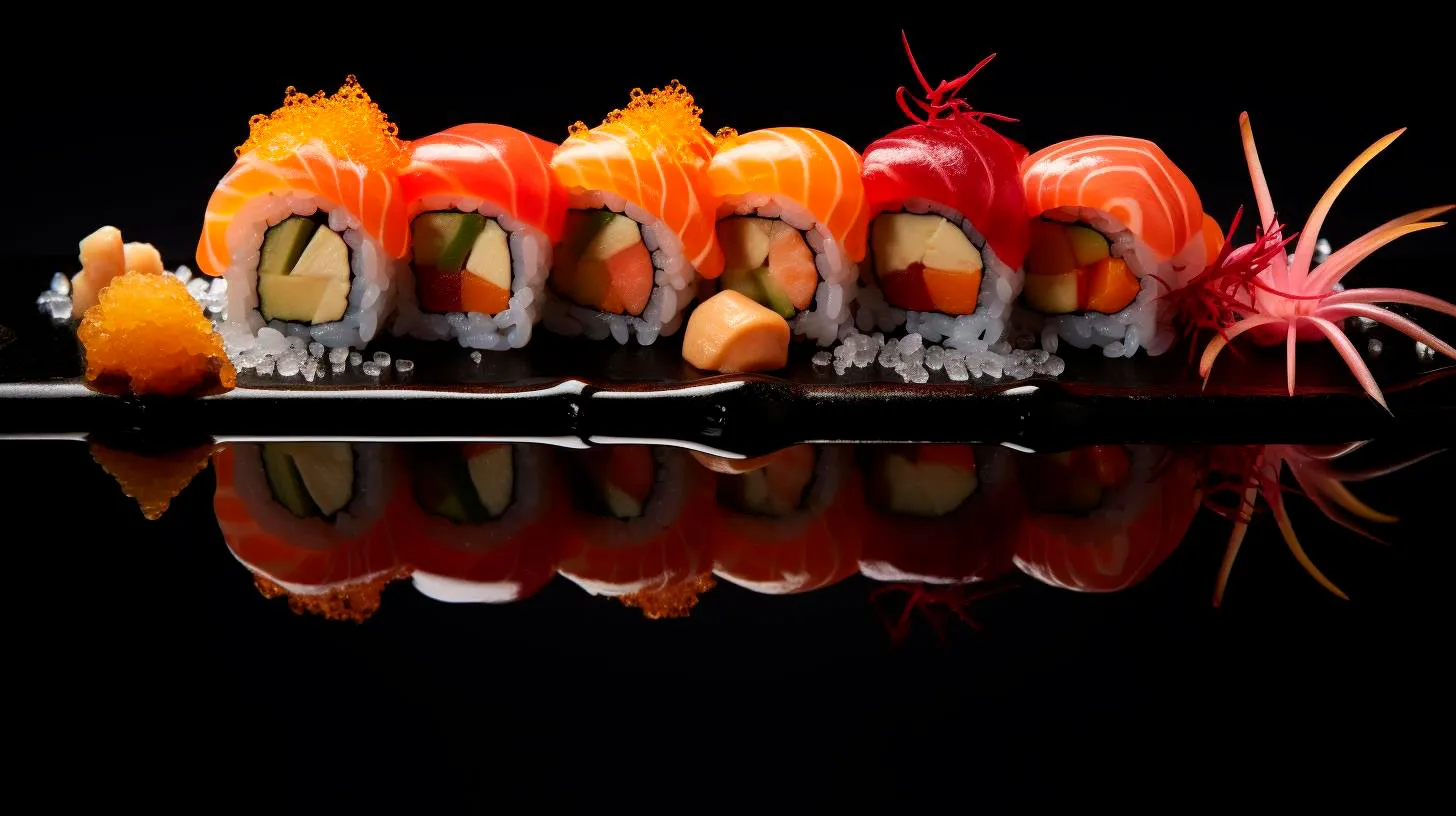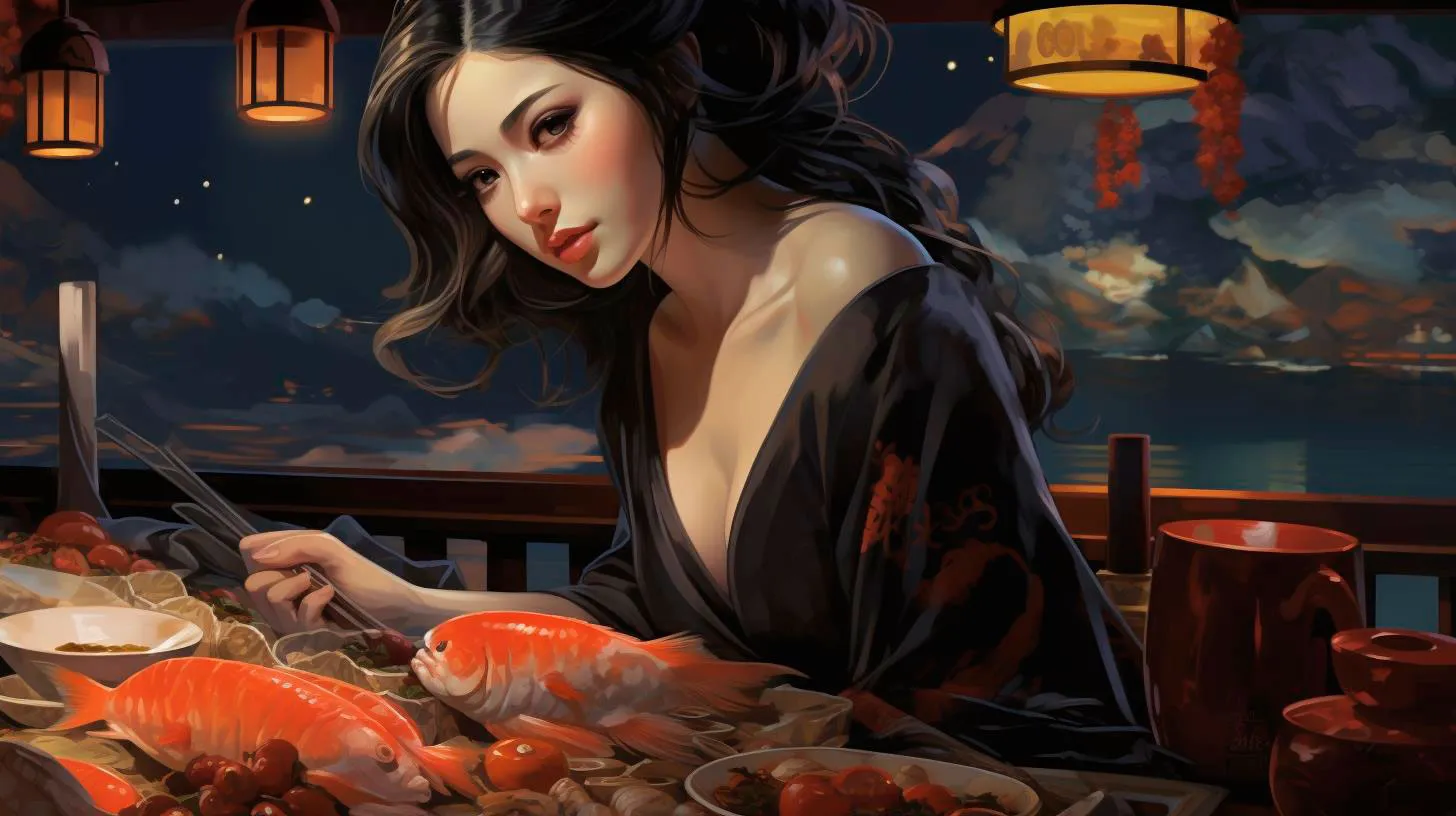From Palette to Plate: Exploring the Visual Delight of Kyoto Gastronomy
In this article, we delve deep into the world of Kyoto cuisine, exploring its unique visual appeal and the cultural significance it holds.
The Art of Kyoto Cuisine
For centuries, Kyoto has been a culinary hub, bestowing immense importance not only on taste and texture but also on aesthetics. The city’s cuisine is a true reflection of the Japanese concept of “shiki-sai” or four seasons. It emphasizes utilizing seasonal ingredients to create exquisite dishes that are not only visually appealing but also harmonious with nature. Each plate is meticulously crafted to represent the colors and textures of the respective season, evoking a sense of harmony and balance.
- Visual Presentation: Kyoto cuisine focuses on visual elements, where an equal emphasis is given to the look and taste of the dishes. Every plate is a work of art, featuring colorful and delicately arranged ingredients.
- Seasonal Ingredients: Kyoto’s changing seasons greatly influence the availability and freshness of ingredients used in its cuisine. The visual appeal of Kyoto dishes is enhanced by the vibrant colors of locally sourced seasonal produce.
- Simple Elegance: Kyoto cuisine embodies the Japanese principle of “less is more.” The minimal use of ingredients allows the natural flavors to shine through, creating a visually stunning yet subtly elegant experience.
- Attention to Detail: From the placement of each ingredient to the choice of tableware, Kyoto chefs pay meticulous attention to detail. Every element is carefully orchestrated to create a visually pleasing and memorable dining experience.
The Delightful Culinary Delicacies
Kyoto offers a wide array of culinary delicacies, each with its own visual allure and unique cultural significance. Let’s explore some of the must-try dishes that showcase the visual delight of Kyoto gastronomy:
Kaiseki Ryori
Kaiseki Ryori is the epitome of Kyoto’s culinary artistry. This multi-course meal features a symphony of small, seasonal dishes that are both visually stunning and meticulously prepared. Every dish is served in carefully chosen porcelain or lacquerware, beautifully enhancing the presentation.
- Seasonal Harmony: Kaiseki Ryori follows the concept of “ichiju-sansai,” with each course carefully curated to match the changing seasons. This creates a visual narrative that reflects the beauty of nature throughout the year.
- Colorful Arrangements: The delicate arrangement of various ingredients, such as fresh sashimi, simmered vegetables, and grilled meats, creates a stunning tapestry of colors on the plate.
- Artful Garnishes: Edible garnishes, like intricately carved vegetables or decorative flower petals, add an extra touch of artistry and elevate the visual appeal of each dish.
Kyo-Yasai
Kyoto is also known for its exquisite selection of unique vegetables known as Kyo-Yasai. These heirloom vegetables are not only visually appealing but also hold a significant place in Kyoto’s culinary traditions.
- Vibrant Colors: Kyo-Yasai exhibits a wide range of vibrant colors, from deep purple eggplants to bright red peppers and yellow squash. These colors add a visually striking element to any dish.
- Distinctive Textures: Each Kyo-Yasai vegetable has its own distinctive texture, adding depth and variety to both the visual and sensory experience of the meal.
- Cultural Legacy: Supporting and consuming Kyo-Yasai helps preserve Kyoto’s agricultural heritage and promotes sustainable farming practices.
Wagashi
No exploration of Kyoto gastronomy is complete without indulging in the delightful world of Wagashi – traditional Japanese sweets. These bite-sized confections are not only visually pleasing but also deeply rooted in Japanese culture and tea ceremonies.
- Pristine Beauty: Wagashi captures the essence of seasonal beauty through its intricate designs and delicate colors. The visual appeal of these sweets enhances the overall experience of traditional tea ceremonies.
- Artistic Expressions: Skilled artisans handcraft each Wagashi, utilizing various cooking methods, shaping techniques, and natural dyes to produce edible masterpieces that reflect the beauty of nature and the changing seasons.
- Symbolism and Tradition: Many Wagashi designs are imbued with cultural symbolism, representing auspicious events, nature, or traditional motifs. They offer a glimpse into Japanese customs and traditions.
Immerse Yourself in the Visual Feast
A visit to Kyoto is an opportunity to immerse yourself in a visual feast like no other. To fully appreciate the visual delight of Kyoto gastronomy:
- Embrace the Seasons: Explore the local markets and dining establishments to savor dishes featuring the freshest seasonal ingredients. Experience the visual transformation of Kyoto cuisine with each passing season.
- Observe Tea Ceremonies: Attend a traditional tea ceremony to witness the meticulous preparation and presentation of Wagashi. Appreciate the artistry behind each intricate sweet and its symbiotic relationship with tea.
- Eat with Your Eyes: Pay attention to the meticulous arrangement and presentation of dishes in Kyoto restaurants. Let your eyes wander before savoring each bite, and take in the harmonious aesthetics.
- Participate in Cooking Classes: Enroll in a Kyoto culinary workshop to learn the techniques behind the artful presentation of Kyoto cuisine. Discover the secrets of creating stunning dishes that captivate both the eyes and taste buds.
Remember, Kyoto gastronomy is not just about taste; it is an immersive experience that celebrates the fusion of flavors, cultural heritage, and visually stunning presentations. Embark on a culinary journey through Kyoto, and let your palate and eyes delight in the enchanting world of Kyo-ryori!
Culinary Craftsmanship: A Journey into the Artful World of Sushi
In this article, we delve into the world of sushi, exploring its history, popular varieties, and the secrets behind its enduring appeal.
The Origins of Sushi
Sushi, as we know it today, has its roots in ancient Japan. Dating back to the 8th century, fermented rice served as a way to preserve fish. Over time, this preservation technique evolved, leading to the creation of different sushi styles. Fast forward to the 19th century, sushi gained worldwide recognition as it was introduced in the United States.
- Sushi originated in Japan as a method of preserving fish using fermented rice.
- The art of sushi-making has been refined over centuries.
- It became popular globally during the 19th century.
The Anatomy of Sushi
Sushi is composed of a few key elements, each playing a crucial role in creating its distinct taste and texture. Here are some essential components:
Sushi Rice
The foundation of any great sushi is the rice. This short-grain rice, known as “shari,” is cooked with vinegar, sugar, and salt, giving it a sweet and tangy flavor. The proper preparation of sushi rice requires great skill and precision to achieve the perfect balance.
Neta (Toppings)
The toppings or ingredients placed atop sushi rice, known as “neta,” can vary widely. From fresh sashimi-grade fish to delicate vegetables and seafood, the neta elevates sushi from mere rice to a culinary masterpiece.
Wasabi and Soy Sauce
Accompanying sushi is the well-known wasabi and soy sauce. Wasabi, a pungent green paste, adds a delightful kick, while soy sauce enhances the flavors. These condiments are traditionally served on the side, allowing diners to customize their sushi experience.
- Sushi is composed of rice, toppings, wasabi, and soy sauce.
- The rice, or “shari,” is prepared with vinegar, sugar, and salt.
- Neta, the toppings, can range from fish to vegetables and seafood.
Types of Sushi
With sushi’s growing popularity, different styles and variations have emerged. Here are a few popular types:
Nigiri
Nigiri sushi consists of a small mound of vinegared rice with a slice of raw fish or other toppings placed on top. This style allows the flavors of the toppings to shine, offering a delightful balance of taste and texture.
Maki
Maki sushi, also known as sushi rolls, includes rice and fillings rolled in a sheet of seaweed called nori. These rolls are often sliced into bite-sized pieces, showcasing a beautiful cross-section of colors and ingredients.
Sashimi
Sashimi, while not technically sushi, is commonly enjoyed alongside sushi. It consists of slices of raw fish or seafood served without rice. The freshness and quality of the fish are of utmost importance in sashimi, allowing diners to experience the pure essence of the ingredients.
- Nigiri sushi features a slice of raw fish or toppings on a mound of rice.
- Maki sushi is rolled with fillings in a sheet of nori seaweed.
- Sashimi is raw fish or seafood served without rice.
The Art of Sushi-Making
Creating sushi is not just about combining ingredients; it is an art form that requires years of training and practice. From the precision of slicing fish to the mastery of rice preparation, sushi chefs, or “itamae,” devote themselves to perfecting their craft.
To become an itamae, individuals often undergo rigorous apprenticeships to learn the intricacies of sushi-making. This dedication ensures that every piece of sushi served is not only visually stunning but also an explosion of flavors in the diner’s mouth.
- Preparing sushi requires years of training and apprenticeship.
- Skilled chefs, or itamae, specialize in the art of sushi-making.
- The goal is to create visually stunning sushi with exquisite flavors.
The Enduring Allure of Sushi
Sushi’s appeal extends beyond its captivating presentation and sensational taste. Here are some key reasons why sushi has stood the test of time:
Health Benefits
Sushi is often associated with being a healthy option due to its emphasis on fresh fish and nutrient-rich ingredients. Rich in omega-3 fatty acids and low in saturated fats, sushi offers a nutritious alternative to many other fast food options.
Accessibility and Variety
With sushi restaurants popping up in cities worldwide, it has become increasingly accessible. Additionally, sushi offers a wide range of options for different dietary preferences. From vegetarian rolls to gluten-free alternatives, there’s something for everyone.
Social and Culinary Experience
Sushi’s communal nature invites people to share and enjoy the art together. Sushi bars often provide an intimate setting where diners can witness the chef’s skill and interact with fellow sushi enthusiasts, creating lasting memories and connections.
- Sushi is rich in omega-3 fatty acids and low in saturated fats.
- It offers a variety of options for different dietary preferences.
- Sushi provides a social and culinary experience for diners.
The Sushi Journey Continues
As sushi continues to captivate taste buds worldwide, its journey into the culinary world is far from over. From traditional sushi to innovative fusion creations, sushi chefs will continue to push the boundaries of this ancient artform.
Embark on your own sushi adventure and experience the beauty and flavors that sushi artisans bring to the table. Whether you’re a seasoned sushi lover or new to this enchanting craft, the world of sushi offers an endless array of possibilities for culinary exploration.
Indulge in the artful world of sushi and ignite your senses with its mastery of culinary craftsmanship!
Vibrant Colors and Intricate Details: Unveiling the Beauty of Kyoto Cuisine
Let’s take a journey into the heart of Kyoto cuisine, exploring its unique features, advantages, and key takeaways.
The Essence of Kyoto Cuisine
Kyoto cuisine, locally known as Kyo-ryori, has deep roots in the cultural traditions of Japan. It embodies the spirit of the ancient capital and reflects the gastronomic philosophy of simplicity, elegance, and attention to detail. Influenced by Buddhist culture and the availability of local ingredients, this style of cooking emphasizes seasonal produce, harmonious presentation, and refined flavors.
The cuisine showcases the traditional Japanese concept of “Shun,” meaning the seasonality of ingredients. Chefs in Kyoto take great pride in using freshly harvested ingredients to create dishes that not only align with nature’s bounty but also highlight the distinctive flavors of each season. This commitment to seasonal produce ensures that every dish is a feast for the senses.
Key Takeaways:
- Kyoto cuisine is deeply rooted in the cultural traditions of Japan.
- It embodies simplicity, elegance, and attention to detail.
- Seasonality of ingredients is a crucial aspect of Kyoto cuisine.
- Freshly harvested ingredients are used to create dishes that align with each season.
The Artistry of Presentation
One of the striking aspects of Kyoto cuisine is its impeccable presentation. Reflecting the Japanese concept of “omotenashi” or hospitality, every dish is meticulously arranged and served with utmost care. The artistry lies not only in the flavors but also in the visual appeal of the dishes.
The colors used in Kyoto cuisine are carefully selected to create a visually pleasing experience. From vibrant green matcha tea to the delicate pink hues of cherry blossoms, each color has significance and adds to the overall aesthetic appeal of the meal. The delicate pottery and lacquerware used as serving vessels further enhance the visual appeal.
Additionally, attention is paid to the spatial arrangement of each element on the plate. The idea is to create a balance between the colors, textures, and flavors, ensuring that the dish is a harmonious symphony for both the eyes and the palate.
Key Takeaways:
- Kyoto cuisine pays great attention to the art of presentation.
- Colors are carefully chosen to enhance the visual appeal of each dish.
- Traditional serving vessels like pottery and lacquerware add to the overall aesthetic.
- Spatial arrangement of elements creates a balance of colors, textures, and flavors.
Refined Flavors and Traditional Techniques
What truly sets Kyoto cuisine apart is the exceptional taste and the skilled techniques employed by the chefs. With a focus on simplicity, the flavors speak for themselves, allowing the quality of the ingredients to shine. Each ingredient is carefully selected and prepared to bring out its natural essence.
The precision and patience required for Kyoto cuisine are reflected in the various cooking techniques used. Steaming, grilling, simmering, and pickling are just a few examples of the mastery displayed by the chefs. These traditional techniques have been passed down through generations, ensuring that the culinary heritage remains intact.
Another notable aspect of Kyoto cuisine is its emphasis on vegetarian and vegan options. Influenced by Kyoto’s strong Buddhist culture, many restaurants offer a wide variety of meat-free dishes. With the same attention to flavors and presentation, these vegetarian options provide a unique dining experience for all.
Key Takeaways:
- Kyoto cuisine focuses on bringing out the natural essence of ingredients.
- The chefs employ various traditional cooking techniques.
- Kyoto cuisine offers a wide variety of vegetarian and vegan options.
- Attention to flavors and presentation is given equal importance in vegetarian dishes.
Discovering the Beauty of Kyoto’s Culinary Heritage
Exploring Kyoto cuisine is like stepping into a world where tradition and innovation coexist harmoniously. Whether it’s a simple bowl of matcha tea or an elaborate multi-course Kaiseki meal, each dish tells a story and celebrates the rich history of this captivating city.
As you indulge in the vibrant colors, savor the intricate details, and relish the refined flavors, you’ll come to appreciate the beauty of Kyoto cuisine. With each bite, you’ll feel a deep connection to Japan’s cultural heritage and gastronomic traditions.
Key Takeaways:
- Kyoto cuisine is a celebration of tradition and innovation.
- Every dish tells a story and reflects Kyoto’s rich history.
- Experiencing Kyoto cuisine allows a deep connection to Japan’s cultural heritage.
- The beauty lies in the vibrant colors, intricate details, and refined flavors.
So, if you find yourself in Kyoto, immerse yourself in the essence of this remarkable cuisine. From the iconic Kaiseki meals to the humble street food stalls, let the vibrant colors and intricate details of Kyoto cuisine captivate your senses and create lasting memories.
Aesthetics in Sushi: Mastering the Art of Visual Presentation
In this article, we explore the significance of aesthetics in sushi and how sushi masters master the art of visual presentation.
The Importance of Aesthetics in Sushi
A beautiful plate of sushi is a feast for the eyes. It is not just the taste that makes sushi a delight; its visual appeal adds to its allure. Here are some reasons why aesthetics in sushi matter:
- Enhances the dining experience: A visually appealing dish stimulates the senses and elevates the overall enjoyment of the meal.
- Cultural significance: In Japanese culture, presentation is considered as important as taste. Aesthetically pleasing sushi reflects the values of balance, elegance, and harmony.
- Marketing advantage: In today’s visually-driven digital world, stunning sushi presentation can attract more customers and help differentiate sushi restaurants from their competitors.
The Art of Visual Presentation
A sushi master strives for perfection in every aspect of sushi creation, including its visual presentation. Here are some techniques they use to achieve this:
Color Palette and Presentation
Sushi masters pay close attention to the color palette of their sushi dishes. They carefully select ingredients that complement each other in terms of color, creating a visually striking presentation. Vibrant colors from fresh vegetables, seafood, and garnishes are used to create an appealing contrast on the plate.
Arrangement and Balance
The meticulous arrangement of sushi is crucial to achieve balance and harmony in its presentation. Each piece of sushi is carefully placed, considering its shape, size, and color. The sushi master ensures that the arrangement is visually pleasing and appealing to the diners.
Garnishes and Decorations
Adding garnishes and decorations is another important aspect of sushi presentation. Thinly-sliced vegetables, edible flowers, and delicate sauces are used to enhance the dish’s visual appeal. These elements add texture, color, and depth to the overall presentation.
Key Takeaways
In conclusion, aesthetics in sushi play a significant role in enhancing the dining experience. Sushi masters go above and beyond to master the art of visual presentation, considering color palette, arrangement, and garnishes. Here are some key takeaways:
- Visual appeal enhances the overall enjoyment of sushi.
- Sushi presentation reflects cultural values of balance and harmony.
- Stunning sushi presentation can give businesses a competitive advantage.
- Color palette, arrangement, and garnishes are key elements in sushi’s visual presentation.
Next time you enjoy a plate of sushi, take a moment to appreciate the artistry behind its visual presentation. The fusion of flavors and aesthetics is what makes sushi a truly remarkable culinary experience.


